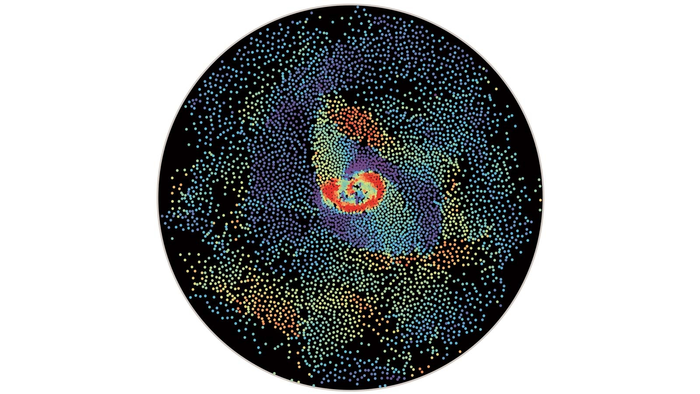Similar to middle school students, microparticles are not the most graceful dancers in the world. For quite a few of them, it is one step forward, one step back.
 Experimental snapshot of a Quincke roller suspension during a vortex reversal induced by a temporal modulation of the activity. Groups of particles with identical colors represent flocks moving in the same direction. Image Credit: Bo Zhang, Alexey Snezhko/Argonne National Laboratory.
Experimental snapshot of a Quincke roller suspension during a vortex reversal induced by a temporal modulation of the activity. Groups of particles with identical colors represent flocks moving in the same direction. Image Credit: Bo Zhang, Alexey Snezhko/Argonne National Laboratory.
Scientists from the U.S. Department of Energy’s (DOE) Argonne National Laboratory have discovered that when an electric stimulus is disturbed and then reapplied with the same orientation, a self-structured vortex of rotating microparticles in a fluid reverses its direction, thereby offering important insights into mechanisms underlying the abrupt switch in rotation.
The study provides a potential stimulus for pumps in microsized channels, known as microfluidic pumps, that enable the measured flow of liquids. Such pumps allow clear-cut fluid delivery for chemical, biomedical and electronics applications.
These vortices of microparticles, which are engineered particles measuring just a millimeter in diameter, display proof of what researchers term “emergent behavior” — a kind of self-structuring and collective motion.
In their innate state, the particles are distributed arbitrarily, but when researchers apply an electric field, they start to coordinate their motion and rotate together either in a clockwise or counterclockwise direction.
The particles are like dancers when we turn on the electric music. When conditions are right, they all start moving with a particular motion tied together.
Alexey Snezhko, Study Lead and Materials Scientist, Argonne National Laboratory
Argonne researchers were keen to explore how these collective self-assembled states can be regulated and exploited. Specifically, they were keen to observe what would occur when they disrupted and then restarted the field powering the motion of the particles.
To their astonishment, the particles’ relative positions formed a sort of distributed collective memory that made them start to rotate in the reverse direction.
“It’s not like these particles have brains,” Snezhko said. “But what’s really interesting is that the collective nature of the vortices enables the entire system to reverse direction.”
The reversal of the particles’ rotation is due to a blend of two types of forces. The first force is termed an electrostatic force, which fundamentally causes adjoining rolling particles to repel one another. This force functions only across short distances — particles have to be touching each other so as to experience it.
The second force is known as a hydrodynamic force — it pertains to the association between the rolling particles and the fluid in the medium they are placed in. The rolling particles generate flows that push and realign particles, and the parallel force works at a longer range.
The collective behavior we see in these particles is similar to that of migrating birds. Obviously, birds don’t want to bump into each other—that’s similar to our electrostatic interaction. However, they also need to match the velocity of birds somewhat farther away—that’s like hydrodynamics.
Alexey Snezhko, Study Lead and Materials Scientist, Argonne National Laboratory
With only the hydrodynamic forces or the electrostatic forces, the reversal would not occur, Snezhko said. “It is a fine interplay between the two forces that drives this phenomenon,” he said.
Snezhko elucidated that the hydrodynamic forces form local asymmetries in the particles’ relative placements within a vortex, which enables the reversal that is eventually activated by the electrostatic interactions.
Although Snezhko stated that the memory of the particle vortices could not function as a computer memory, he said that the system’s reversal could be beneficial for materials that run on a toggle system, such as microfluidic pumps or other types of biomechanical switches, for instance for drug delivery.
Active materials like these self-assembled particle vortices have a wide range of potential applications. Characterizing the behavior of these systems under a range of conditions is essential for being able to control and make the most of their properties.
Alexey Snezhko, Study Lead and Materials Scientist, Argonne National Laboratory
The study has been published in December 23rd, 2021 online issue of the journal Nature Physics
Other authors of the study include Argonne’s Bo Zhang and Andrey Sokolov, as well as Hang Yuan and Monica Olvera de la Cruz of Northwestern University. The study received funding from the DOE’s Office of Science (Office of Basic Energy Sciences).
Journal Reference:
Zhang, B., et al. (2022) Polar state reversal in active fluids. Nature Physics. doi.org/10.1038/s41567-021-01442-6.